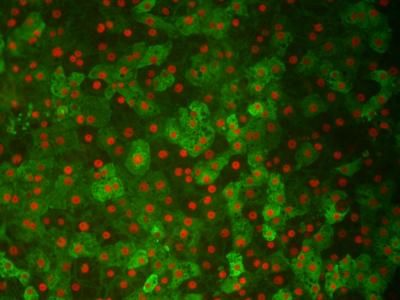Campus Vienna Biocenter: New role for a known signaling molecule
Advertisement
The Raf-1 protein plays a key role in determining how liver cells react to signals for the activation of a self-destruction program. A group at the Campus Vienna Biocenter has discovered this hitherto unknown function of the long-known signal molecule in murine cells. Future avenues for the development of therapies for a whole range of liver diseases have been opened up by the results of this project, funded by the Austrian Science Fund (FWF).
A protection mechanism known as apoptosis is activated when there are problems with the liver. The Fas receptors on the surface of the liver cells play a special part in activating this protection mechanism - they pick up the signal molecule known as FasL and then initiate the self-destruction of the cells.
A team led by Prof. Manuela Baccarini of the Max F. Perutz Laboratories, Department of Microbiology and Immunobiology of the University of Vienna, has now been able to demonstrate that the amount of Fas receptors on the cell membrane is regulated by the Raf-1 protein. The researchers have proved that cells unable to produce Raf-1 contain up to five times more Fas receptors.
The published results provide an explanation for the fact, discovered some time ago, that Raf-1 has an important function in embryonic development, as it suppresses the unwanted activation of the cell death program by the FasL signal molecule. It is now clear that this effect is brought about by regulation of the number of cell surface receptors which are responsible for activation.
When Raf-1 is lacking, however, the efficiency with which the individual receptors initiate the suicide program is also less than when Raf-1 is present at normal levels. This dual effect - more receptors but less effective - prompted Dr. Baccarini to propose a model for the effect of Raf-1. In this, Raf-1 acts on another protein, Rok-alpha, which has an impact on the binding of the receptors with components of the cytoskeleton. This binding is necessary both for the recycling of the receptors and for their complete functional efficiency. If the binding is disturbed, a large number of receptors that function less effectively collect on the cell surface.
The protection program activated by the Fas receptors can play a number of very different roles in connection with liver diseases. In the case of infections or rejections it destroys liver cells that could actually be saved by modern medicines. In such situations it is important to stop this program. The opposite applies to liver tumours. These bring about a weakening of the Fas-dependent self-protection and can thus continue to grow. Here, a strengthening of the protection program would be desirable so that the tumour cells could be killed off. The project¹s findings now point to a central role for Raf-1 in the regulation of the self-protection mechanism, and thereby offer a starting point of for future therapies for a wide range of liver diseases.
Original publication: Piazzolla et. al.; "Raf-1 sets the threshold of Fas sensitivity by modulating Rok-alpha signaling."; J Cell Biol, Vol. 171 (6).

























































